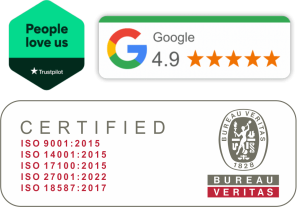RFP and Tender Translation Services
Your gateway to global business excellence.


WHY CHOOSE OUR TRANSLATION SERVICES?
Here at Skrivanek, we specialize in offering unparalleled translation services for requests for proposals (RFPs) and tenders, serving as a bridge for your global business success. In the world of international business, where opportunities span borders and languages, the clarity and precision of your documents can make all the difference. Our expertise ensures that your RFPs and tenders are not just translated, but transformed into tools that convey your company’s professionalism, attention to detail, and commitment to quality.
Navigating the intricate requirements of RFPs and tenders can be challenging, especially when dealing with multiple languages and diverse cultural contexts. That is where our skilled team comes in, as we do more than just translate words since we also translate the meaning, intent, and nuances, ensuring that your message resonates with its intended audience. Through Skrivanek, you can confidently step into the international arena, knowing that your critical business documents reflect your company’s high standards and align perfectly with the expectations of your global partners.


In a fast-paced business environment, we understand the importance of responsiveness and adherence to deadlines. That is why our services are not only about linguistic accuracy but also about timely delivery, ensuring that your international bids and proposals are submitted without delay. With Skrivanek as your translation partner, you gain a competitive edge in the global marketplace, ensuring that language barriers never stand in the way of your business growth and success.
What do RFPs and tenders involve?
RFP: This is a document issued by a company or organization to solicit proposals from potential suppliers or service providers. It is a comprehensive outline of the company’s needs and requirements, enabling the suppliers to propose solutions tailored according to these needs.
Tender: This is an invitation to bid for a project or to supply goods or services. In business, issuing or responding to a tender is a formal, structured invitation to suppliers to compete for the supply of products or services.
WE LOOK FORWARD TO
HEARING FROM YOU!

Why choose Skrivanek for your RFP and Tender Translations?
- Expertise in multiple languages: Our team of skilled translators covers a wide range of languages, ensuring that your RFPs and tenders are accessible to a global audience.
- Industry-specific knowledge: We match your documents with translators who have expertise in your specific industry, ensuring accuracy and relevance.
- Confidentiality and security: Your documents are handled with the utmost confidentiality and security, preserving your business’s integrity.
- Timely delivery: We understand the importance of deadlines in RFPs and tenders, and are committed to delivering translations within the timeframe you require.
- Quality assurance: Our rigorous quality control process ensures that every translation meets the highest standards of clarity, accuracy, and professionalism.
RFP and tender translation services
At Skrivanek, we offer specialized translation services for RFPs and tenders. Our expertise ensures that your business communications are not only accurate but also culturally and contextually relevant.
When do you need to use these services:
- International bidding: You can rely on our services when bidding for projects in countries where the language differs from your own.
- Legal compliance: This is essential for ensuring that all legal terms in foreign RFPs and tenders are understood and adhered to.
- Technical proposals: When your RFPs or tenders contain technical jargon, our industry-specific translators can accurately convey the complex information.
- Cross-cultural negotiations: To ensure that cultural subtleties are respected and correctly interpreted, which is crucial for international negotiations.
- Multinational collaborations: When collaborating with companies from different linguistic backgrounds, our services ensure clear and effective communication.
- Government contracts: They are particularly useful when dealing with government tenders, which often require precise language and adherence to formal guidelines.
What we offer:
- Extensive language coverage: Our team is proficient in numerous languages, offering a broad spectrum for translation.
- Customized industry solutions: We provide specialized translation services tailored to various industries, such as technology, healthcare, construction, and finance.
- Document adaptation: Beyond mere translation, we adapt your documents to suit the cultural context and business etiquette of the target region.
- Comprehensive support: From initial translation to final proofreading, we offer complete support throughout the whole translation process.
- Technical precision: Our translators are adept at handling complex technical terminologies, ensuring precise translations for specialized documents.
- Efficiency and reliability: We are committed to delivering your translated documents within the agreed timeframe without compromising quality.
The RFP and Tender Translation Process
Translating RFPs and tenders requires accuracy, the use of appropriate terminology, and full compliance with industry standards. Therefore, it is a complex process that ensures the highest quality of the final product.
What are the stages of tender documentation translation?
1. Receiving the request from the client and preparing a preliminary quote.
2. A thorough project analysis helps determine:
- the source and target languages;
- the scope of the material – which documents should be translated, whether any particular areas require special attention;
- file formats;
- industry-specific requirements;
- formal requirements (e.g., whether the text should be prepared for a specific platform or whether a certified translation will be required);
- whether any additional services will be required (e.g., preparing the document for printing).
Based on this, a detailed quote is prepared.
3. Discussing all details with the client and signing the contract.
4. Selecting the suitable translator or an entire team of specialists with extensive industry knowledge and experience in working with tender documentation. If a certified translation is required, a translator with this qualification is selected.
5. Terminology analysis and preparation of a glossary with key terms and their translations – this ensures terminological consistency throughout the text. Typically, the glossary is created in collaboration with the client or based on previous projects.
6. Precise translation of the documentation. This often utilizes CAT (computer-assisted translation) tools and translation memories to speed up the process and increase consistency. If necessary, the translation is certified, meaning that after completion, a sworn translator certifies its compliance with the original with a signature, stamp, and a special declaration attached to the documents.
7. Proofreading, performed by a native speaker, is intended to identify and eliminate spelling, punctuation, and stylistic errors, ensuring the text reads as fluently and naturally as the original. Independent review is also possible, performed by a second translator, also a specialist in the field. This process corrects the entire content for substantive and terminological accuracy.
8. If the text contains graphics within the text, DTP is performed. This may include precisely reproducing the original’s appearance and preparing the text for printing or publication on a specific platform, in the appropriate format. After the process, a pre-print proofing is performed – a proofreading process focusing on editorial errors and formatting issues.
9. Internal quality assurance – specialists perform this process to identify any final errors, such as translation omissions or typos.
10. The text is submitted to the client, who either accepts it or provides feedback.
Tender Translation – Formal and Cultural Differences
Tenders in each country have their own specificities, which influence the way documents are translated. This is crucial because it helps avoid errors, increase the chances of selecting the right candidate, and, above all, meet the formal requirements of public institutions. What are the key differences to note?
- Document structure – In Poland, tenders are often structured as a SWZ, often in a single PDF file or divided into attachments. Other European Union countries use standardized templates, while the US uses a request for proposal (RFR) divided into sections: executive summary, scope of work, requirements, and evaluation.
- Communication style – In Poland, this should be more formal, while in Scandinavia, for example, it should be concise and simple.
- Importance criteria – In Poland, low price usually prevails, while abroad, greater emphasis is often placed on quality, experience, sustainability, and diversity requirements; this influences which parts of the document the translator must pay particular attention to.
- Systems – different countries use different platforms, so translating documents from one format to another or the composition of tender documents may also be important.
- Local references – for example, regarding important documents (Ustawa – Prawo zamówień publicznych in Poland; other laws in other countries) or identification methods (NIP and REGON in Poland, DUNS number in other countries); these must be adapted to local rules or at least explained.
- Cultural elements – for example, the notation of dates.
Send a quote today
In a world where business opportunities are boundless, language barriers should never hold you back. Sending a quote to us is your first step towards expanding your global reach. With our expertise in RFP and tender translations, you can confidently step into new markets and seize international opportunities. Our commitment to precision, cultural sensitivity, and timely delivery sets us apart, making us the ideal partner for your global ventures. Never let language barriers limit your potential. Contact us today to get a quote, and see how we can help bridge the gap between your business and the world.
